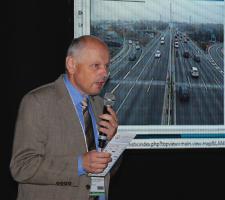
Vehicle manufacturers have targeted 2015 for the first cars to roll off European assembly lines fitted with operational V2X technology. They and their partners in the Car 2 Car Communications Consortium are confident of meeting the target, reports Jon Masters.
Around three years from now vehicles should be appearing in showrooms boasting the capability of communicating with each other.Manufacturers will have started fitting the first proprietary car-to-car driver-aid safety devices and deployment of ‘vehicle-to-x’ (V2X) cooperative vehicle communication will be underway in earnest.
That is, if the 12 major vehicle manufacturers of the European
If the world’s car companies do not have V2X advertised in their brochures throughout Europe by 2015, it is likely that they will have in years following as competition takes hold.
The Car 2 Car Consortium’s target has been set by a memorandum of understanding (MoU) signed by the 12 manufacturers, pledging a common approach to deployment to standards being drawn up in Europe.
The MoU was announced at this year’s
Growing consortia
Car 2 Car is now a consortium of 60 members. The vehicle manufacturers (including
For instance, Europe’s association of road toll concessionaires
Each stakeholder has its own primary concerns and objectives. The Amsterdam Group has been formed to bring them together, or at least to ensure good communication between all four.
A Car 2 Car member writes....
For BMW – an active member of the Car 2 Car Communication Consortium – important considerations with regard to V2X include customer value and experience of V2X functionalities, a company spokesperson writes: ‘It is vital that functions developed can be experienced on the majority of Europe’s roads and it is very important to have a good balance between V2V and V2I functions. Both classes of function are likely to become very valuable, such as Intersection Assist as a V2V function or GLOSA (Green Light Optimal Speed Advisory) as a V2I function.
‘The German simTD (Safe & Intelligent Mobility Testfield Germany) research project is a very important building block in this joint work. Within simTD, all relevant stakeholders of cooperative mobility for a safe and efficient transport are working together, and results are expected in 2013.
‘The Car 2 Car Consortium, together with the Austrian infrastructure project
Igniting deployment
“Our primary objectives have been to secure a royalty-free frequency band for V2X, which we got at 5.9GHz for Europe in 2008, and standardisation, which is now well developed. We are now hoping to be entering the stage of deployment, but the question has been, how do we get started?The MoU has been initiated because any one car company cannot be expected to develop the necessary systems alone. Market penetration is needed.
The bigger the penetration the bigger the benefit and for this the OEMs need to synchronise.
In 2015 we should see the first vehicles rolling off the assembly lines with cooperative systems.”
Initially, in-vehicle V2X systems are expected to take the form of driver assistance safety devices alerting drivers to other vehicles nearby or approaching.
How this is done – with audio or visual alerts on dashboards or vibrations in drivers’ seats or steering wheel – will be down to each manufacturer.
“This will create competition, which is good. We like that,” Proskawetz says.
Standard progress
The simplicity of this start point for V2X, with basic standardised ‘I am here’ messages communicated between vehicles, is one reason to suggest the 2015 target will be met. Another is the relative maturity of the standardisation process.
In response to the
Two years later, ETSI has completed its technical specifications and standards for V2V communication.
It is important to do this gradually, consulting with all stakeholders at each stage.”
Therein lies a substantial difficulty for the overall initiative. V2X has a lot of stakeholders to consult and a lot of validation processes to clear via operational field testing. This last is progressing across a number of fronts, spearheaded from sites including SCORE@F in France, Germany’s simTD ‘safe and intelligent mobility’ test field near Frankfurt and the EC’s Drive C2X collection of test projects.
Numerous uses or applications of V2X are being developed, such as traffic signal harmonisation for smoothing traffic flow or prioritising public transport and emergency vehicles, or mobility applications based on communication of real-time information.
“There are a lot of use cases in mind but all cannot be introduced at once. The start point has to be certain limited functionality, then grow from there,” says Proskawetz.
Differences compatible
The presumption from the Car 2 Car Consortium is that deployment of V2X proper will begin in cars. The rhetoric is not altogether the same from all partners of the Amsterdam Group, however. For POLIS, whose focus is on transport innovation at city and regional, or sub-national level, the emphasis of priority is on mobility for all.According to its secretary general Sylvain Haon, POLIS is fully committed to continuing dialogue with other stakeholders:
“It is important we do that. Many of our members believe we are going to have more cooperative systems on our transport networks, but we insist on referring to this in terms of vehicles, because it is not all about the car,” Haon says.
“The whole picture is about the mobility of the individual and we would rather see a focus on more policy led applications, such as improvement of public transport.
But while all stakeholders are not agreeing on everything, there are some interesting developments coming and we are happy with progress overall.”
A delegation from the Amsterdam Group were due to meet with the European Commission in November, partly to brief the EC’s new director of innovative and sustainable mobility Olivier Onidi on V2X developments and what its partners want, “and to show the EC that the stakeholders are working together”, Haon says. “Our priorities may be different but there is no reason why they cannot be compatible.”
Nothing comes for free
At ASECAP the mood is more cautionary. The organisation is also pragmatic, understandably so given that it represents private sector road operators, whose revenues come at the expense of almost continuously reminding the public and politicians that road operations and services never come for free.“Our members want to provide a good service to road users, but new value-added services such as V2X have to be provided at a cost that users will be willing to pay for.
The new ideas have to make sense to the market,” says ASECAP secretary general Kallistratos Dionelis.
“We very much believe in the holistic approach of the Amsterdam Group. It is much better to have a common understanding of what we want as a group, but as a key stakeholder and member of the EC’s new ITS advisory group, we will be urging others not to run too fast.
“Why does the technology have to be on the vehicle? Manufacturers care little of how and where vehicles are used once sold, whereas highway managers are responsible for how traffic performs.
Tolled road operators want motorways used, they want users to be happy with the service and for contracts to be profitable. For greatest value, V2X really ought to start with I2I (infrastructure to infrastructure), which is what we will point out to the EC. At present road networks cannot even talk to each other well.”
Committed to the cause
Much of ASECAP’s principal concerns are directed at a similar political level: “ITS is a tool, but if policy is not intelligent then the ITS won’t be either,” Dionelis says.
The V2V efforts of the Car 2 Car Consortium are less likely to come up against the political or institutional debate that surrounds infrastructure operated by public or private sector. It is also apparent that vehicle manufacturers believe there is a market for V2X as additional driver aids at very least.
They are certainly demonstrating a commitment to the cause – each is believed to be putting a five figure sum towards Car 2 Car every year, in addition to their own R&D costs, and many are deeply involved in Europe’s V2X deployment test projects.
Daimler’s senior manager for driver support at the company’s Research & Advanced Engineering Group, Matthias Schulze, is also the project coordinator of the EC sponsored Drive C2X.
With responsibility for an R&D team developing V2X for Mercedez-Benz and other parts of the Daimler group, and a self-professed personal aim of seeing V2X deployed, Schulze is “very confident” that the technology will reach European roads from 2015. “It may not be all OEMs that introduce this from 2015 due to the various lifecycles of their different models, but some will and the others are sure to follow,” he says.
“There will be a limited number of vehicles fitted with V2X initially, but it is not necessarily V2V that will come first. We are now very confident in Germany that our ministry for traffic will provide the necessary investment in infrastructure needed for V2I and I2V, which is minimal as much of the cables and necessary communication connections are already in place and it’s largely the same in Austria and The Netherlands.
We are expecting an MoU to be signed by national road agencies soon, so things are moving along nicely.”
A vision of the infrastructure side of V2X
The SWARCO Group has drawn up a step by step scenario for deployment of the infrastructure side of V2X required for the first generation of cooperative systems. SWARCO has undertaken significant internal development of associated technology and represented the ITS industry in several of the EC’s V2X research initiatives, so is well placed to predict likely deployment scenarios.
This it has done by analysing various different prospects of technology and business cases. SWARCO envisages short range ETSI G5 compliant road side units (RSU) initially installed at three types of location: they would be fitted to signalised intersections to allow enhancement of signal phase timing using data from passing vehicles, while sending information to drivers, such as ‘time to green’; RSUs would be located on VMS gantries, allowing significant improvement in the usefulness of displayed messages as a result of more detailed real-time and vehicle-specific information; and they will be sited at isolated ‘hot spots’ where communication with vehicles can be valuable, at accident ‘black spots’ or road construction sites, for example.
SWARCO has summarised a number of key points in relation to this likely scenario. For instance, although short range communication (ie, ETSI G5) is the particular component of V2X, existing mobile phone networks are already being used. Progressively, coverage with short range communication will spread, responding to reliability and continuity requirements.
Non-safety related information applications will start first in V2X infrastructure deployment, according to SWARCO. Safety related application will follow in a second stage when vehicle penetration is higher and short range communication is more widely spread. The company points out that V2X is not just a matter of ‘a few roadside units’; the complete ‘value chain’ and necessary architecture are key factors. The role of traffic control centres in fusing data and ensuring consistency of information delivered to vehicles will be decisive.
Completion of standards publication, as well as their profiling and certification are essential steps to guarantee deployment. In most cases, existing ITS systems will need to be upgraded step-by-step, to protect earlier investments and according to the typical lifecycle of the roadside infrastructure. Cloud computing and future internet will provide the opportunity to extend the solutions to smaller cities by introducing a service-based model for the offering. Furthermore, in-vehicle aftermarket solutions and services of independent suppliers are expected to become available in addition to those of vehicle manufacturers.
Several other details and useful applications are envisaged, but currently SWARCO’s first priority is ‘to be ready with simple and effective solutions for V2X on day one’.












